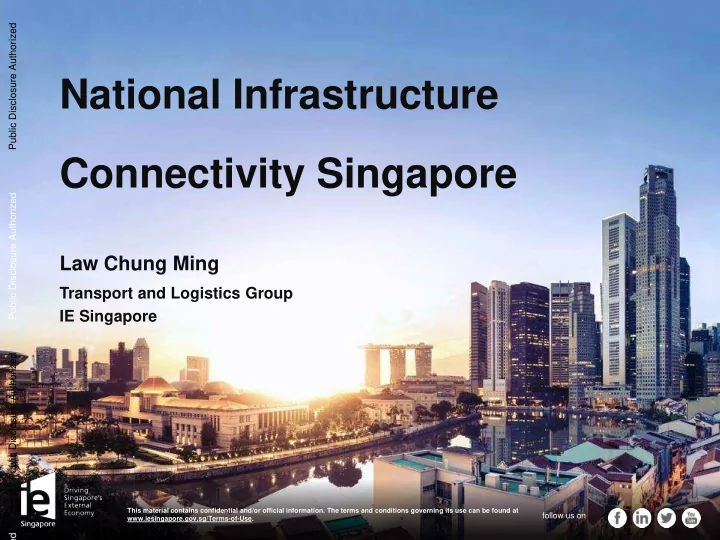

Public Disclosure Authorized National Infrastructure Connectivity Singapore Public Disclosure Authorized Law Chung Ming Transport and Logistics Group IE Singapore Public Disclosure Authorized This material contains confidential and/or official information. The terms and conditions governing its use can be found at follow us on www.iesingapore.gov.sg/Terms-of-Use. Public Disclosure Authorized
Last 50 years : Singapore’s airport and seaport have grown to be amongst the world’s leading transport hubs and are important enablers for regional trade Singapore has done well for the past 50 years… “ We started off with no hinterland and a weak economy . We depended on our entrepot trade, but our neighbours were building their own ports and sought to bypass us. Our workers were unskilled and anxious about their future but we are determined to make the world our hinterland.. And with that workforce, we made PSA and Changi, the best in the world.” Lee Hsien Loong, Prime Minister of Singapore
Transformation of our airport and seaport Kallang Airport Paya Lebar Airport Changi Airport Seletar Airport and 1937 – 1955 1955 – 1980 1981 – Present 1928 – Present A Singapore dock in the 1990s Port of Singapore today
Our transport hubs play a significant role in the economic development of Singapore Seaport Airport Contributes to Direct value-add from Changi 7% Airport of Singapore's Indirect value-add GDP About Employs more than 6% of 30.9mil 170,000 GDP Induced value-add TEUs of containers people handled Catalytic impact of value-add through tourism, productivity, More than trade and investment 5,000 maritime establishments Employs about 55,000 55.4mil people passenger in 2015 Singapore Ranked 1 ST in McKinsey Global Institute Connectedness Index MGI Connectedness Index, published in 2016
Getting ahead of the game: Major development plans to take Singapore’s aviation and maritime capabilities to greater heights Seaport Airport CONSOLIDATION & Terminal 1 Future Port Infrastructure Current Port EXPANSION Existing Facilities Facilities Terminal 2 Terminal 3 Infrastructure Terminal 4 Future Tuas Terminal Terminal 5 Pasir Panjang Terminal To be operational from 2021 The new infrastructure will more than double our capacity Port expansion 3-runway system will be projects including construction of the operational from early 2020s Tuas facility will cost a City Terminals few billion dollars
Key lessons from Singapore’s experience in infrastructure connectivity over the last 50 years Capacity Building Physical - Developing capacity for our airport and seaport in anticipation of future trends and growth to facilitate trade and investments Talent – Investing in education, developing specialised and sectoral skilled talents Progressive policies Concerted efforts between private and public sectors in enabling pro-enterprise policies formulation Pro-business partnerships Form strategic, mutually beneficial partnerships e.g. with key trading partners through FTAs to facilitate trade, lowering trade barriers
Next 50 years: What lies ahead for Singapore? What do we need to do for SG100. . . “As SG50 ends, the next chapter of the Singapore Story begins. We live in a very different world from our pioneers fifty years ago. Yes, we have many more opportunities in the globalised world, but we also face fiercer competition . Yes, we have more resources, but we also have higher aspirations. Our economy is slowing down and undergoing transition. We cannot expect an easy journey ahead.” Lee Hsien Loong, Prime Minister of Singapore
Singapore evolving to stay ahead with the changing geometry of global trade flows Emergence and Development of New Economic Trade Corridors ASEAN Economic Community Trans Pacific Partnership One Belt One Road (AEC) (TPP) (OBOR) The TPP is a trade agreement China’s “One Belt, One Road” AEC is a major milestone in the between 12 countries, including the regional economic integration agenda (OBOR) aims to connect major US, Mexico and Australia, which aims in ASEAN, offering opportunities in Eurasian economies through to promote jobs and growth, enhance the form of a huge market of US$2.6 infrastructure, trade and productivity and competitiveness, and trillion and over 622 million people. investment. boost economic growth in the United AEC is collectively the third largest States and across the Asia-Pacific economy in Asia and the seventh region. largest in the world. 8
Given the backdrop, what should Singapore do… • Expanding beyond capacity building • Building the eco-system and supporting industries • e.g. aerotropolis • Looking beyond physical connectivity • Information & IT • Finance & Capital • Forging Stronger Partnerships • Government-to-Government, Government-to- Business and Business-to-Business
Evolving from airport to aerotropolis Cargo flows Hotels/ Convention Specialised Centres (MICE) Infrastructure (Coolport) Retail/ Outlet Malls airport Logistics Parks & FTZs MRO Integrated Entertainment Centre Industrial/ Residential Business Parks developments
Stronger Partnerships to capture opportunities in connectivity Government to Government Working with the region and ASEAN as a platform to enhance connectivity and trade Government to Business Encouraging Public-Private Partnerships Business to Business Facilitating strategic partnerships between companies to build flows
To recap Last 50 years … Singapore’s airport and seaport have grown to be amongst world’s leading transport hubs and are important enablers for global trade We have built capacity, developed progressive policies and formed pro-business partnerships Next 50 years … Singapore "cannot just bulldoze and build" as it embarks on its next 50 years. Singapore has built a brand on its success and trust and we should build on this for Singapore to continue being successful. Singapore will continue to look beyond capacity building, beyond physical connectivity and form strategic partnerships to remain relevant and globally connected
Thank You www.iesingapore.com This material contains confidential and/or official information. The terms and conditions governing its use can be found at www.iesingapore.gov.sg/Terms-of-Use.
Recommend
More recommend